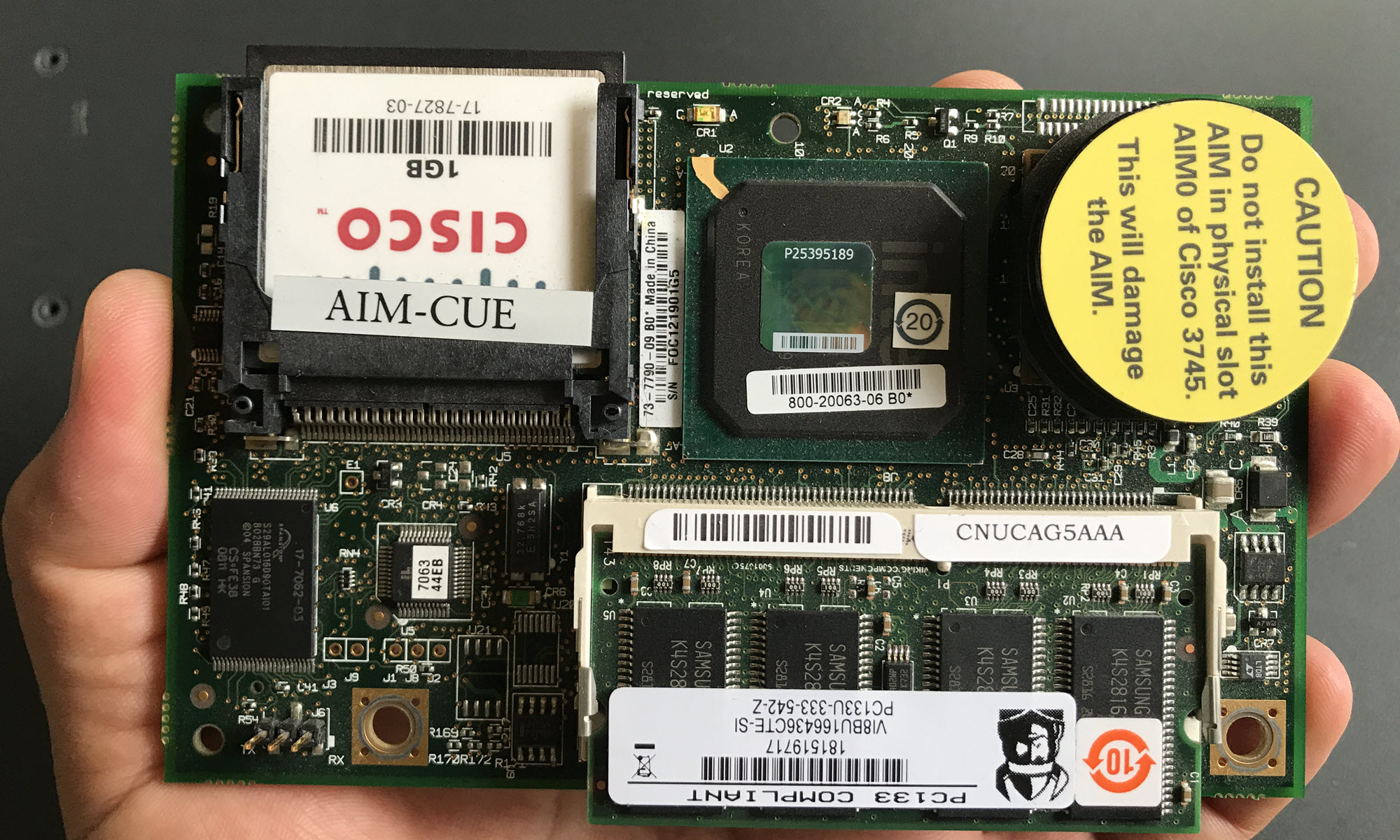AIM-CUE Session
We’ve covered so far a bunch of very interesting topics on our journey to familiarize ourselves with the AIM-CUE, things like, unpackaging, physical installation, logical connection, IP addressing, IP Unnumbered and also IP Routing using an static route, we are ready to move forward to the next step, opening our very first session, let’s do that.
First let’s double check we do have proper connectivity:
ping 172.16.1.103
vgw#ping 172.16.1.103
Type escape sequence to abort.
Sending 5, 100-byte ICMP Echos to 172.16.1.103, timeout is 2 seconds:
!!!!!
Success rate is 100 percent (5/5), round-trip min/avg/max = 1/1/1 ms
vgw#Opening a session
You’ll see that at the end of the day, opening a new session with our CUE is just like going from one device to the other using telnet, see the CLI command we have to use below:
service-module Service-Engine 0/1 session
vgw#
vgw#
vgw#service-module service-Engine 0/1 session
Trying 172.16.1.1, 2386 ... Open
SYSTEM ONLINE
CUE-751>
CUE-751>
CUE-751>Congratulations! You are finally inside the Cisco AIM-CUE for the very first time, awesome! job well done!
Returning to the original (router) session
Permanently
Once we are done with whatever we were doing on our AIM-CUE and we want to go back to the router, closing permanently the current connection with CUE, we must use for these cases, the “exit” CLI command, see below:
CUE-751> exit
[Connection to 172.16.1.1 closed by foreign host]
vgw#Briefly, wanting to resume the session
Because we are just opening a new telnet session with our CUE, as you can imagine, we can also use the very well known key combination (Ctrl-Shift-6-X) to get back to the original session, but leaving the possibility to resume the current CUE session by just pressing Enter.
See below the effect of pressing “Enter” immediately after the key combination.
vgw#
[Resuming connection 1 to 172.16.1.1 ... ]
CUE-751>
CUE-751> As you can see, the shell resumes the CUE session, and that is very useful for cases where configuring the CUE we have to wait for it to complete a given task.
We don’t have to just sit in front of the computer waiting for CUE to complete its task, what we can do instead, is to go back to router to do other things meanwhile, knowing that we can quickly resume the CUE session, because it was left intentionally open.
Show sessions currently open
From the original (router) session we can check if there is any open session, see command below:
- show sessions
vgw#show sessions
Conn Host Address Byte Idle Conn Name
* 1 172.16.1.1 172.16.1.1 0 0 172.16.1.1
vgw#> Disconnect Session
The output of the “show sessions” command is necessary to get the session ID, in the example above that number is “1”, you’ll use the session ID number to close that particular session, see command below:
- disconnect 1
vgw#disconnect 1
Closing connection to 172.16.1.1 [confirm]
vgw#The “Good Old” question mark symbol
Now that we are finally inside our CUE for the very first time, we can ask for help using the old good question mark symbol, you can see a list of the available options below:
CUE-751>
CUE-751>
CUE-751> ?
<cr>
CTRLZ
ccn Telephony application
clear Reset functions
configure Enter configuration mode
copy Copy data from one location to another
disable Turn off privileged commands
echo print the arguments
enable enter privileged mode
erase Erase a configuration
exit quit the cli
groupname Group descriptions and accounts
insert-line Insert a line of text
log System event messages
mwi Message Waiting Indicator
network commands associated with networking
no Negate a command
offline Change the system to administration mode
ping Send echo messages
reload Reboot the system
remote commands associated with remote info
service Services on the system
show Show running system information
shutdown Halt the system
software software
techsupport Generate debug related information for support
terminal Configure this session's terminal
trace Enable trace events for debugging
username User descriptions and accounts
voicemail voicemail application
web define username for GUI user
webapp Commands associated with web applications
write Write running configuration to memory or terminal
CUE-751>
CUE-751> Show me more
Aren’t you already curious about what the “show” CLI command have to offer? let’s take a look right now:
CUE-751>
CUE-751> show ?
arp ARP table
backup Print backup utility configuration
calendar Print calendar schedule information
ccn Telephony Application
clock Display the system clock
configuration Contents of Non-Volatile memory
cores List the core files
crash Show kernel crash information
crypto Encryption module
debugging State of each debugging option
errors Print statistics about system events
fax Fax details
group Print information about a single group
groups Print list of known group names
hosts IP domain-name, lookup style, nameservers, and host table
imap IMAP server
interfaces Show interface status and configuration
ip IP application
list Print information about a single distribution list
lists Distribution lists
log Print recent system event messages
logging Show console logging options
logs List the logs
memory Memory statistics
messaging-gateway Messaging gateway
network Networking application
notification Notification
ntp Network time protocol
packets Network traffic
parser Display parser information
phone-authentication IP phone services authentication server
privilege Print information about a single privilege
privileges Print list of known privileges
processes Application subsystem state
remote commands associated with remote info
restriction-table Restriction table for outbound calls
running-config Current operating configuration
security Print information about security settings
smtp SMTP Server details
snmp SNMP configuration
software software
startup-config Contents of startup configuration
sysdb System configuration database
system Print system information
tech-support Summary of diagnostic information for Cisco TAC
trace Show trace information
user Print information about a single user
users Print list of known usernames
version System hardware and software status
voicemail Telephony application
voiceview Voice Mail Phone Service Application
web GUI interface
webapp Print list of loaded web applications
CUE-751>Where to go from here
I think we have now a lot of “home-work” to do, many options to check and the opportunity to finally get to know ALL about our AIM-CUE, let’s continue with a few more “show” CLI commands then.


